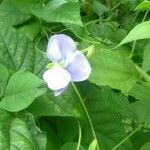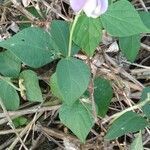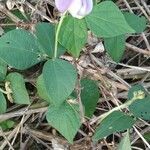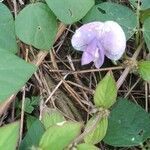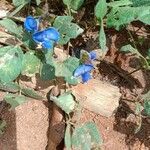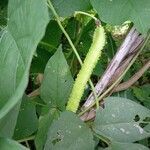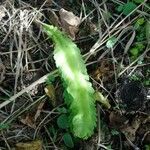Herbs, annual or perennial, climbing, with tubers. Stems 2-3 m or more, glabrous. Stipules dorsifixed, ovate to lanceolate, 0.8-1.2 cm; petiole sulcate; leaflets ovate-deltoid, 4-15 × 3.5-12 cm, base truncate or rounded, apex acute or acuminate. Racemes axillary, 1-10 cm, 2-12-flowered; peduncles 5-15 cm; bracteoles suborbicular, 2.5-4.5 mm in diam. Calyx campanulate, ca. 1.5 cm. Standard green outside, pale blue inside, ca. 3.5 cm in diam., base appendaged, apex emarginate; wings pale blue, ca. 3 cm, with T-shaped auricle at middle of claw; keel white tinged with pale blue, slightly incurved with rounded auricle at base. Legumes yellow-green or green, sometimes with red spots, tetragonal, 10-25(-40) × 2-3.5 cm, wings 0.3-1 cm wide with serrate margins. Seeds 8-17, white, yellow, brown, black, or variegated, subglobose, 0.6-1 cm in diam., shining, margin arillate. Fr. Oct-Nov.
More
A climbing perennial bean up to 3 or 4 m tall. It can re-grow each year from the fattened roots. The stems twine around supports or trail over the ground. The leaves have 3 leaflets. The leaf stalks are long. The leaflets are 8-15 cm long. The flowers are blue or white. They occur on the ends of branches from within the axils of leaves. Pods have wavy wings or are roughly square in cross section. They are 6-36 cm long with 5-30 seeds. Seeds can be white, yellow, brown or black. They are bedded in the solid tissues of the pod. The seeds are round smooth and brown with a small hilum. Nodules on the roots are many and large.
A tropical plant. The bean grows from sea level up to about 1850 m altitude in the tropics. It normally only produces tubers between 1200 and 1850 m. Because of the effect of daylength it will not produce flowers or pods at places far removed from the equator. Photoperiodism limits pod availability in higher latitudes but this should not be significant in the equatorial latitudes. Winged bean is a short day plant. It needs a daylength less than 12 hours. Winged bean is a plant ideally suited to the tropics including the hot humid lowlands. Papua New Guinea is a centre of diversity for winged beans and they are grown in many areas of the country. They can be seen from sea level up to about 2300 m altitude although they are less common above 1850 metres and normally only produce tubers between 1200 and 1850 m altitude. For maximum seed production winged beans need temperatures between 23°C and 27°C and for tubers the temperatures should be between 18°C and 22°C. This means the main areas of production occur between 20°N and 10°S latitudes. Winged beans can grow on a wide variety of soils. Winged beans have been grown on soils with pH from 3.6 to 8.0. Soils which are very acid have soluble aluminium to which winged beans are sensitive. Soils should not be waterlogged. In Yunnan.
Seeds are sown at the beginning of the rainy season. Seeds germinate and grow slowly for the first 3 or 5 weeks. For tubers, vines are pruned off at about 1 m high (or left unstaked) and some flowers are removed. Winged beans are grown for their edible roots, edible leaves, edible flowers, edible pods and edible seeds. The cultivation procedures vary slightly depending on which product is the preferred goal. The two main types of winged bean are short podded ones which are used for tubers and long podded ones which have poor tubers. Tuber production is not as efficient in tropical lowland conditions. Production is from seed. Phases of development:-1. Germination 5-16 days; 2. Vegetative growth till flower buds 46-92 days; 3. Flowering duration ? 4. Pod development 10-13 weeks after planting; 5. Tuber development 4-5 months after planting. Winged beans are predominantly self pollinated but limited out-crossing has been reported. Hard seed coats have been reported from dried stored seed. The amount of vegetative growth increased with increasing pH from 4.7 to 5.5. Nitrogen percentage in tissues increased with pH from 4.7 to 6.2 Winged beans have been grown in soils with pH between 3.6 and 8.0. Winged bean is sensitive to aluminium in soil solution. Plants are intolerant of water-logging. Flowering is inhibited by low levels of solar radiation. Shading improves pod length and seed number. Root knot nematode can cause severe damage in some places. Seeds are planted 2-3 cm deep and about 25-35 cm apart. If seeds have been dried and stored then they can suffer from hard seed coats and this delays the germination of seeds. But normally seeds start to grow in about 15 or 16 days. Plants grow slowly to start with so weeding is important but then they grow rapidly. After 46 to 92 days they are producing flowers. If fattened roots are important some of the leaves and flowers and tips are pruned off at this stage. These can be eaten. Pods develop 10 to 13 weeks after planting and tubers occur 4-5 months after planting. For tubers production plants are planted seasonally to allow them to mature during the dry season. Winged beans need to be staked for high yields. Winged bean root nodules containing Rhizobia bacteria are very large, inoculation occurs easily and naturally and nitrogen fixation is efficient. This both enables winged beans to grow well and have a high protein content but can also help provide nitrogen in the soil for other plants.
